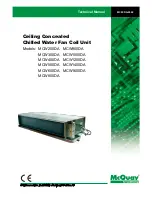
Hot insulation/cold insulation common procedure
The materials and their thickness for hot insulation/cold insulation are shown in Table 1.
1. Use a bonding agent, iron wire, iron band, or other suggested bonding agents, to fix the hot
insulation/cold insulation materials. Never rivet them. Do not use welding pins.
2. Make the outer covering, flanged parts, and evaporator water chamber casing easily
removable to facilitate servicing. The points that require hot insulation/cold insulation are
shown in Table 2.
3. The casing of the absorber/condenser water chamber does not require hot insulation/cold
insulation. If insulation is used, make it easily removable.
4. For the high temperature generator, install the insulation so that the front, sides, and rear can
be removed separately. In addition, make a removable part around the rear end for inspection
of the temperature relay and sensor.
Note:
The cold and hot insulation standard unit is of factory scope. The SQ or optional
design gives the insulation guide later such as split type, with auxiliary heat exchanger
design.
Table 1: Insulating material and thickness
Hot insulation
Cold insulation
Material
Rock wool or glass wool
Polyurethane foam, polystyrene foam, or glass wool
Thickness
2 in. (50 mm)
2 in. (50 mm)
Table 2: Points requiring hot/cold insulation
Point requiring hot insulation
Point requiring
cold insulation
Point that must not
be heat-insulated
High temperature generator
Evaporator shell
Sight glass
Flue
Evaporator water chamber case Valve manipulator
Heat exchanger
Refrigerant spray piping
Pressure gauge
Low temperature generator
Refrigerant blow piping
Thermometer insertion hole
Auxiliary heat exchanger for
heating function (option)
Point carrying “Hot Insulation”
label
• Point carrying “Cold
Insulation” label
• Valve for vacuuming (factory
use only)
Relay insertion hole
37
Model YHAU-CGN/H-CXR(M)Double Effect Direct Fired Small Absorption Chiller-Heater
















































